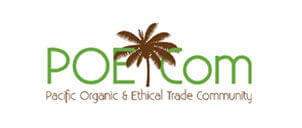 Click here to learn about our policy tree
Click here to learn about our policy tree Learn about our policy tree
The breadfruit tree, ubiquitous in the Pacific Community islands, represents the organic policy process. The Toolkit is not just a set of elements. It like a tree emerging from the soil. The soil is the foundation from which the policy development process arises and finally yields fruits (results).
The soil consists of the principles of organic agriculture and its potentials to enhance sustainability of the Pacific Islands – their environment and the physical, economic and social health of their people.
Embedded in the soil are the roots of the Policy Tree, which are:
- Knowledge and understanding of organic agriculture and its potentials. The Toolkit features several tutorials related to this:
- Commitment to developing organic agriculture to achieve key objectives
- Government support for organic agriculture: a global overview
- Cooperation between governments and key stakeholders.
- Article: Public-Private Collaboration on Organic Agriculture and Trade
The trunk of the tree is a solid strategic planning process, which arises out of the knowledge, commitment, and cooperation and channels them in order to develop the branches of the tree.
The primary branches of the tree are four pathways of strategic policy actions that can be taken to support develop organic agriculture. These pathways are:
- “push” strategies to support the development of organic agriculture and other elements of the value chain for organic products.
- “pull” strategies to stimulate demand for organic products
- “ enabling” strategies to provide a supportive environment for organic agriculture
- strategies to eliminate policies with negative impacts on organic agriculture
Secondary branches arising from the primary ones are the possible actions associated with each of the four strategy pathways. For example, actions under “push” strategies could include targeted organic agriculture research, support for organization of grower groups, and government sponsored development of bio-fertilizer production facilities.
Not all possible actions will be able to be undertaken, and there will be a pruning event to delete some of them from further planning and development. The remaining chosen actions will get more nutrients and space to grow well.
Activities to implement the chosen actions are the twigs from which the fruits (results) will emerge. Activities depend on chosen actions and are situation-specific. Therefore they are not further elaborated in this toolkit.
Nurturing the Policy Tree – Elements of the Toolkit
The vision further includes means of nurturing the tree, and these are in two thematic areas
- policy development guidance
- tools and instruments
The toolkit’s elements are aligned with these two themes.
Policy guidance for developing an Organic Agriculture Policy
- A Guidance for the Strategic Planning Process document containing advice and lessons learned from other policy development on organic agriculture, eg. Balancing push-pull measures, linkage with related policy and plans, using regional networks (POETCom and High Level Task Force), engaging high level support.
Tools/instruments
- Case examples of strategic organic plans
- Decision framework for organic policy development (affecting pruning)
- Outline for Strategic Organic Plan
- Guidance for developing Organic Regulation
- Guidance developing Organic Promotion Policy

